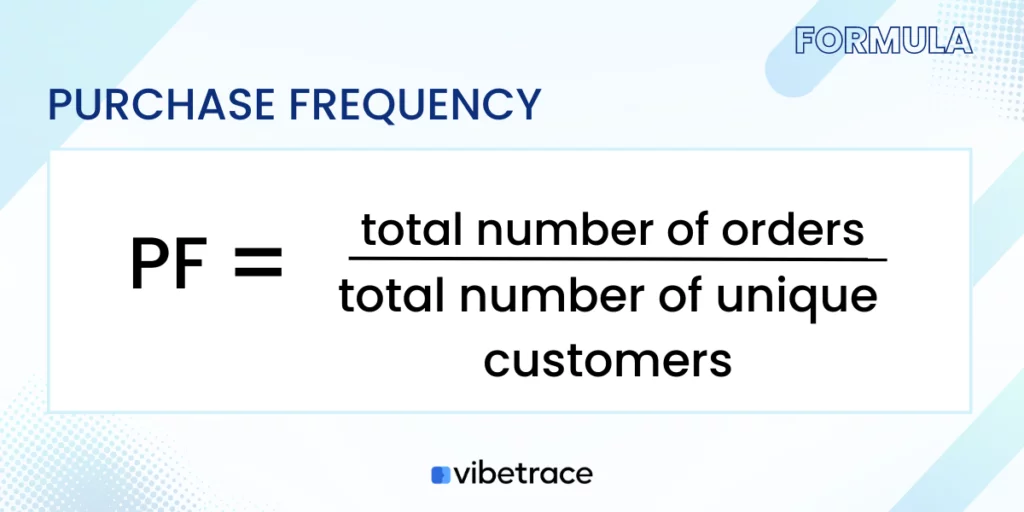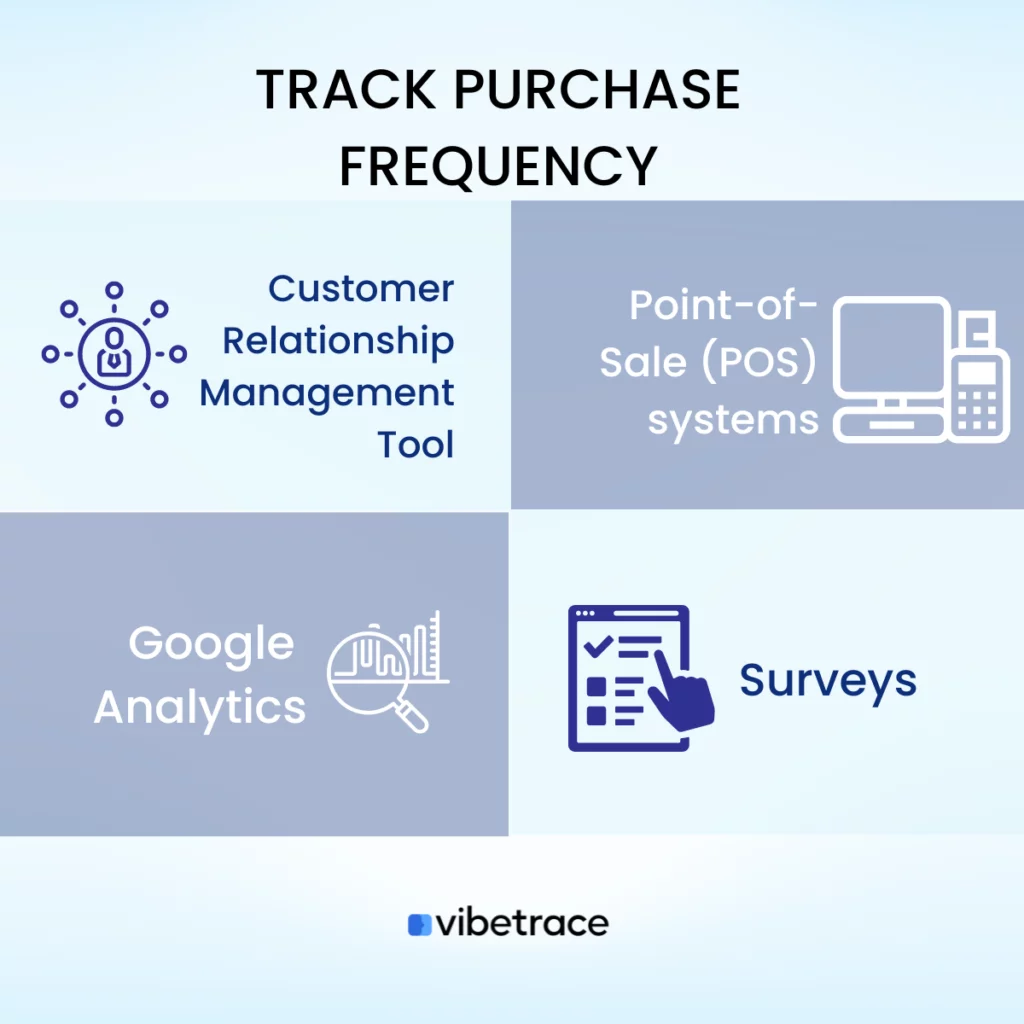Purchase frequency is a metric that allows businesses to keep track of customer loyalty.
Most businesses struggle to maintain a good purchase frequency, which suggests that customers may not be satisfied or happy with their first purchase. This kind of problem may lead to a need for changes in pricing strategy or product improvement.
However, this metric is not limited to customer loyalty. It has a bigger impact on business revenue and customer repurchase rate.
The goal is to encourage customers to make repeat purchases and keep them, loyal customers, as this is a key factor in the success of a business.
To achieve this, it can be beneficial to advertise products that have been purchased frequently, as this suggests that most customers have liked them.
This is especially relevant when tracking your business’s purchase frequency.
What is Purchase Frequency?
Definition of Purchase Frequency
Purchase frequency refers to the number of times a customer buys a product or service from a particular business over a specific period of time, such as a month or a year.
It is a metric used by businesses to track how often customers make repeat purchases and to evaluate customer loyalty.
Businesses can gain valuable insights into customer behaviour and identify areas for improvement in their pricing, products, or services by measuring purchase frequency.
Furthermore, tracking purchase frequency can be cost-effective since repeat shoppers are more affordable to acquire than new customers.
This is because loyal customers are more likely to refer others to the business once they are satisfied with their experience, resulting in potential new customers without the need for expensive marketing efforts.
So, If you are looking forward to the success of your business you must understand that Increasing purchase frequency is an important goal for businesses as it can lead to higher revenue and long-term customer loyalty.
Purchase Frequency Formula

This formula calculates the average number of times customers make purchases from a business during a specific period, such as a month or a year.
The total number of orders is divided by the total number of unique customers who made those orders to arrive at the purchase frequency.
For example, if you had 500 orders in a month from 100 unique customers, the purchase frequency would be 5 (500 orders / 100 unique customers).
This means that on average, each customer made 5 purchases during that month.
Purchase Frequency by Industry
Purchase frequency can vary by industry due to differences in customer behavior, product offerings, and market competition. Here are some examples of purchase frequency by industry:
Grocery: In the grocery industry, purchase frequency is typically high since customers need to buy food and household items regularly.
The average purchase frequency in this industry is around once a week.
Fashion Retail: In the fashion retail industry, purchase frequency can vary based on the product offering and target market.
Fast fashion brands tend to have higher purchase frequency as they release new collections frequently, while high-end luxury brands may have lower purchase frequency due to their higher price points.
E-commerce: In the e-commerce industry, purchase frequency can vary depending on the type of product or service offered.
For example, subscription-based businesses may have higher purchase frequency as customers receive products or services on a regular basis.
Businesses that sell durable goods may have lower purchase frequency as customers only need to make purchases when the product needs to be replaced or upgraded.
Understanding purchase frequency in a specific industry can help you as a business owner to make informed decisions about marketing strategies, product offerings, and pricing.
How to track Purchase Frequency?
There are several tools and methods that you can use to track purchase frequency:

Customer Relationship Management (CRM) software: CRM software can be used to track customer behavior, including purchase frequency. Many CRM systems have built-in analytics and reporting features that allow you to track purchase frequency over time.
Point-of-Sale (POS) systems: POS systems can track purchase frequency by capturing transaction data and customer information. You can use this data to generate reports on purchase frequency and other key metrics.
Google Analytics: Google Analytics can track website visitors and their behavior, including purchase frequency. By setting up goals and tracking e-commerce transactions, you can get insights into customer behavior and purchase frequency.
Surveys: Conducting customer surveys can also help businesses to track purchase frequency. By asking customers how often they make purchases, you can get a better understanding of their behavior and adjust their strategies accordingly.
How often should you check Purchase Frequency?
The frequency with which you should check purchase frequency depends on various factors, such as the size of your business, the industry it operates in, and the goals it has set.
In general, it is recommended to track purchase frequency on a regular basis, such as weekly or monthly, to get an accurate and up-to-date understanding of customer behavior.
However, the frequency of tracking can also depend on the type of business and the products or services it offers.
For example, if your business has a high-value product with a long purchase cycle, it may be more appropriate to track purchase frequency on a quarterly or bi-annual basis.
It is also important to note that tracking purchase frequency alone may not be enough to gain a complete understanding of customer behavior. It should be combined with other metrics, such as customer lifetime value and customer satisfaction, to get a holistic view of customer loyalty and retention.
Purchase Frequency Calculator
Do you want to calculate your purchase frequency? Use our simple calculator below.
A good purchase frequency needs to have a value greater than 1 for a specific period of time.
Purchase Frequency Rate Calculator
Important Things about Purchase Frequency
Here are some important things to know about purchase frequency:
Measures customer loyalty: Purchase frequency is a metric that measures the number of times a customer makes a purchase from your business over a specific period of time. A higher purchase frequency indicates greater customer loyalty, while a lower frequency suggests that customers may not be satisfied or engaged with the business.
Help identify areas for improvement: By tracking purchase frequency, you can gain insights into customer behavior and identify areas for improvement in their pricing, products, or services.
Using customer behaviour insights you can start building up marketing automation flows to convert them into repeat customers.
For example, if customers are not making repeat purchases, it may be a sign that your business needs to adjust its pricing strategy or improve the quality of its products.
Impacts business revenue: Repeat customers are cheaper to acquire than new customers, and they also tend to spend more money per transaction. Therefore, a higher purchase frequency can lead to increased revenue and profitability for your business.
Tracked alongside other metrics: Purchase frequency is just one metric that you can use to measure customer loyalty and retention. It should be tracked alongside other metrics, such as customer lifetime value and customer satisfaction, to get a complete understanding of customer behaviour.
Vary by industry: Purchase frequency can vary widely by industry and product type. For example, customers may make frequent purchases of consumable goods, but less frequent purchases of high-value items like cars or appliances. Therefore, you should consider industry-specific benchmarks and trends when tracking purchase frequency.
Simply put, purchase frequency is an important metric for your business to track, as it can provide valuable insights into customer behavior and loyalty.
By understanding purchase frequency and taking steps to improve it, you can increase revenue, improve customer retention, and drive long-term growth.
Metrics related to Purchase Frequency
There are several metrics related to purchase frequency that you can track to gain insights into customer behavior and loyalty. Here are some of the most important metrics:
Average Order Value
Customer Lifetime Value
The estimated total value of a customer to a business over the course of their lifetime
Time Between Purchases
The average amount of time that elapses between a customer’s orders.
Repeat Purchase Rate
The percentage of customers who make more than one purchase from your website.
Churn Rate
The percentage of customers who stop using a product or service over a given time period.
Customer Satisfaction Score
The measure of how satisfied customers are with a company’s products or services.
Vibetrace offers multiple methods to increase purchase frequency, including providing customers with personalized and engaging experiences to enhance customer loyalty and encourage more purchases.
Additionally, one effective way to bring back lost customers is through email marketing, by offering exclusive discounts and promotions for their next purchase.

